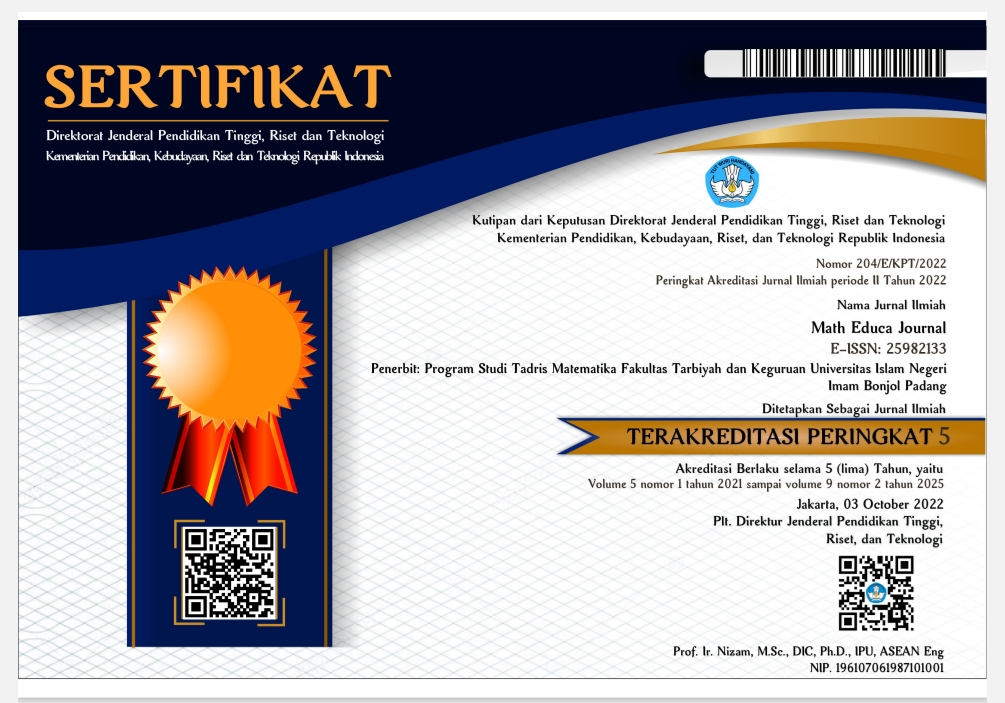ANALISIS TINGKAT KOGNITIF SOAL BUKU TEKS MATEMATIKA SMA/MA KELAS XII TERBITAN KEMENDIKBUD REVISI 2018 MATERI STATISTIKA BERDASARKAN TAKSONOMI BLOOM REVISI
Abstract
The aim of this research was to determine the distribution of the cognitive levels on problem questions and competency test questions of statistics chapter in the mathematics textbook of Senior High School for 12th grade published by the Ministry of Education and Culture revised edition of the 2018 based on the revised of Bloom’s taxonomy. The revised of Bloom’s Taxonomy used was the cognitive process dimension which consists of: remembering (C1), understanding (C2), applying (C3), analyzing (C4), evaluating (C5), and creating (C6). This type of research is descriptive research with the research method used is qualitative research. The data collection technique in this research is using the documentation technique. Sources of research data in this research were problem questions and competency test questions of statistics chapter in the mathematics textbook of 12th Grade revised edition of the 2018. The exercise questions and the competency test questions had 45 questions with the distribution of the cognitive levels are remembering (C1) has 2 questions (4,4%), understanding (C2) has 12 questions (26,7%), applying (C3) has 23 questions (51,1%), analyzing (C4) has 4 questions (8,9%), evaluating (C5) has 4 questions (8,9%), and creating (C6) has 1 question (2,2%). Thus, the distribution of cognitive levels of problem questions and competency tests on statistical material is not proportional.
Keywords
Full Text:
PDFReferences
Depdiknas. (2006). Permendiknas No. 22 Tahun 2006 Tentang Standar Isi. Jakarta: : Departemen Pendidikan Nasional
Effendi, R. (2017). Konsep Revisi Taksonomi Bloom Dan Implementasinya Pada Pelajaran Matematika Smp. JIPMat, 2(1), 72-78. https://doi.org/10.26877/jipmat.v2i1.1483
Helmawati. (2019). Pembelajaran dan Penilaian Berbasis HOTS. Bandung: PT Remaja Rosdakarya
Isro’atun, & Rosmala, A. (2018). Model-Model Pembelajaran Matematika. Bandung. PT Bumi Aksara.
Jakni. (2016). Metodologi Penelitian Eksperimen Bidang Pendidikan. Bandung: Alfabeta.
Kemendikbud. (2016). Permendikbud 24 Tahun 2016 tentang KI, KD Sekolah Dasar dan Menengah. Jakarta: Kementrian Pendidikan dan Kebudayaan.
Prastowo, A. (2015). Panduan Kreatif Membuat Bahan Ajar Inovatif. Yogyajarta: DIVA Press.
Raditya, A., & Iskandar, R. S. F. (2020). Analisis Soal PLSV pada Buku Ajar Matematika dari Kurikulum 1994 hingga Kurikulum 2013. Phenomenon: Jurnal Pendidikan MIPA, 9(2), 232-245. https://doi.org/10.21580/phen.2019.9.2.4066
Saepulloh, A. R., Sumarna, N., & Permana, T. (2016). Studi Tentang Ketercapaian Standar Uji Kompetensi Siswa Dalam Mata Pelajaran Pemeliharaan Kelistrikan Di SMK. Journal of Mechanical Engineering Education, 3(2), 154-158. https://doi.org/10.17509/jmee.v3i2.4544
Sugiyono. (2019). Metode Penelitian Kuantitatif, Kualitatif, dan R&D. Bandung: Alfabeta.
Syarifah, L. L., Dewi, W. K., & Tangerang, U. M. (2020). Analisis Soal-Soal Pada Buku Ajar Matematika Siswa. 04(02), 1259–1272. https://doi.org/10.31004/cendekia.v4i2.335
Utari, Retno., & Madya, W. (2011). Taksonomi bloom: Apa dan Bagaimana Menggunakannya? Pusdiklat KNPK.
Refbacks
- There are currently no refbacks.

This work is licensed under a Creative Commons Attribution-NonCommercial-ShareAlike 4.0 International License.
The Journal Space of the Mathematics Education Department
Faculty of Education and Teacher Training
State Islamic University of Imam Bonjol Padang
Email: mej.uinibpadang@gmail.com

Math Educa Journal is licensed under a Lisensi Creative Commons Atribusi-NonKomersial 4.0 Internasional.
Based on a work at https://ejournal.uinib.ac.id/jurnal/index.php/matheduca.
All rights reserved p-ISSN: 2580-6726 | e-ISSN: 2598-2133




